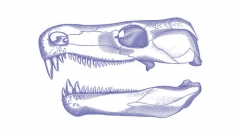

 Comptes Rendus Palevol
23 (9) - Pages 119-129
Comptes Rendus Palevol
23 (9) - Pages 119-129The reconstruction process of the skull and skeleton represents a critical step in the study of fossil vertebrates and is often responsible for how the evolutionary history of a taxon is interpreted. It is also an important step in any test of the researcher’s understanding of the anatomy of the fossil. Even so, there is no recognized method for its completion, leaving the actual process to the individual undertaking the investigation. While this is often accomplished in an appropriate manner, there remains extensive room for error. With the onset of cladistic methodology dating back to the 1980s, character state description has become ever more critical in establishing phylogenetic histories, and over a period of 40 years, character state interpretation has often relied on specimen drawings and reconstructions. Based on a career dedicated to the detailed skeletal reconstruction of tetrapods, the content presented here highlights a stepwise approach that is designed to minimize error and increase the value of fossil reconstructions. We describe the skull reconstruction of the Palaeozoic tetrapod Limnoscelis paludis Williston, 1911 and highlight some of the more critical strategies that are necessary to maximize accuracy and hence increase phylogenetic reliability as well as support opportunities for testing anatomical interpretations as well as functional and ultimately behavioural interpretations. We also take the opportunity to highlight the extensive career contributions made to the field of palaeontology by Diane Scott, who for over 40 years has represented the nec plus ultra of fossil preparation, illustration, and reconstruction.
Skeletal reconstruction, specimen drawings, reconstruction techniques